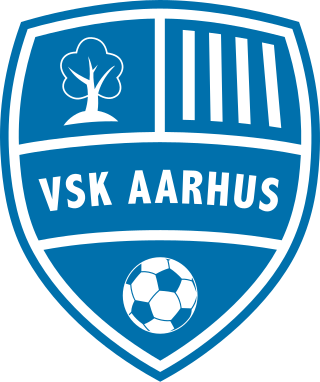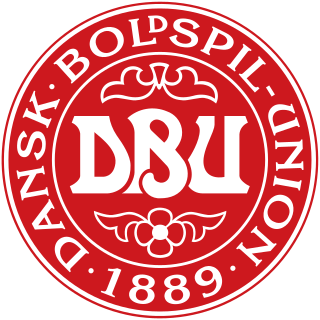Related Research Articles

Brønshøj BK, full name Brønshøj Boldklub, is a Danish football club located in the outskirts of Copenhagen. The club was founded on 15 May, 1919.

Association football is the most popular sport in Denmark, with 331,693 players and 1,647 clubs registered under the Danish FA. The game was introduced into Denmark by British sailors. Kjøbenhavns Boldklub is the oldest club outside of the United Kingdom, having been founded on 26 April 1876.

The 2nd Division is a professional association football league for men and the third division in Denmark. It is organised by the Divisionsforeningen on behalf of the Danish Football Association as part of the nation-wide Danmarksturneringen i fodbold (Herre-DM) and is positioned between the second-tier 1st Division and the fourth-tier Danish 3rd Division in the Danish football league system. Clubs in the league must meet certain criteria concerning appropriate facilities and finances. All of the 2nd Division clubs qualify for the proper rounds of the DBU Pokalen. The number of promoted and relegated clubs has fluctuated over the years. In the 2020–21 season two clubs were directly promoted to the 1st Division, while eight teams were relegated to the Denmark Series. From the 2021–22 season, it was changed to two promotion spots and two relegation spots.

Fodbold Club Fredericia af 1991 is a professional association football club based in the town of Fredericia, Denmark, that competes in the Danish 1st Division, the second tier of the Danish football league system. Founded in 1991 as a merger between Fredericia fF and Fredericia KFUM, it is affiliated to DBU Jutland. The team plays its home matches at Fredericia Stadium, named Monjasa Park for sponsorship reasons, where it has been based since 2006.
Slagelse Boldklub & Idrætsforening, commonly known as Slagelse B&I, is an association football club based in Slagelse, Denmark, that competes in the Denmark Series, the fifth tier of the Danish football league system. Founded in 1887, making it the fifth oldest club in the country, it is affiliated to DBU Zealand. The team plays its home matches at Slagelse Stadium, which has a capacity of 10,000. Between 2008 and 2015, the club's first team went under the name of FC Vestsjælland.

Vendsyssel Forenede Fodboldklubber is a professional football club based in Hjørring, Denmark. The team competes in the Danish 1st Division, the second tier of Danish football. The club plays home matches at Nord Energi Arena, which has a capacity of 7,500. The club is playing on a license from Hjørring IF, which used to belong to FC Hjørring. The club is a cooperation between Hjørring IF and Frederikshavn fI.

Vejlby Skovbakken Aarhus is a Danish football club based in Risskov, a neighbourhood in Aarhus. The club was founded in 2016 when the football departments of Vejlby IK Fodbold and Idrætsklubben Skovbakken decided to merge. Skovbakken is a major multi-sport club who besides football also compete in basketball, handball, badminton, tennis, and volleyball, with many honours won in these departments.

SfB-Oure FA is a Danish professional association football club based in the town of Svendborg, that competes in Danish 3rd Division, the fourth tier of the Danish football league system. Founded in 2018 as an elite superstructure of Svendborg fB and Oure FA, it is affiliated to DBU Funen. The team plays its home matches at Høje Bøge Stadium where it has been based since its foundation.
The Danish Women's League is a semi-professional top-flight league for women's football in Denmark. It is organised by the Danish Football Association (DBU) as part of the nation-wide Danmarksturneringen i kvindefodbold (Kvinde-DM) and is placed as the first division of the Danish football league system. Clubs in the league must meet certain criteria concerning appropriate facilities and finances. All of the league's clubs qualify for the proper rounds of the DBU KvindePokalen. The top teams of each season qualify for the UEFA Women's Champions League.
Copenhagen Series for men, unofficially also known as Københavnerserien and often shortened to KS serien and KS Herre, is the highest division for men organised by the regional football association DBU København (DBUK) and one of the sixth-highest divisions overall in the Danish football league system.

Vejgaard Boldspilklub is an association football club based in Vejgaard, a suburb of Aalborg, Denmark, that competes in the Danish 3rd Division, the fourth tier of the Danish football league system. Founded in 1925, it is more simply known as 'Vejgaard BK' or 'VB'. The team plays its home matches at Soffy Road.

FC Djursland is an association football club based in the town of Grenaa, Denmark, that competes in the Jutland Series, the sixth tier of the Danish football league system. The club is a merger established in Djursland in 2009, originally between five parent clubs. Today, three clubs remain in the merger: Grenaa IF, AC Norddjurs and Østdjurs 91. FC Djursland is affiliated to DBU Jutland, and plays its home matches at Grenaa Idrætscenter where it has been based since 2009.
The Danish football league system, also known as the football league pyramid, refers to the hierarchically interconnected league structure for association football in Denmark, in which all divisions are bound together by the principle of promotion and relegation. Within men's association football, the top two professional levels contain one division each. Below this, the semi-professional and amateur levels have progressively more parallel divisions, which each cover progressively smaller geographic areas. The top four tiers are classed as nationwide, while the fifth tier and below are classed provincial leagues. Teams that finish at the top of their division at the end of each season can rise higher in the pyramid, while those that finish at the bottom find themselves sinking further down. In theory it is possible for even the lowest local amateur club to rise to the top of the system and become Danish football champions one day. The number of teams promoted and relegated between the divisions varies, and promotion to the upper levels of the pyramid is usually contingent on meeting additional criteria, especially concerning appropriate facilities and finances.

DBU Zealand is the local governing body for association football and futsal on Zealand, Denmark. They are responsible for the governance and development of men's and women's football at all levels in the region. DBU Zealand is a member of the Union of Local Football Associations in Denmark under the Danish Football Association (DBU) and National Olympic Committee and Sports Confederation of Denmark (DIF). The headquarters is located in Himmelev in the northern part of Roskilde. Clubs situated on Zealand and surrounding areas, covering the postal codes between 3000-3699 and 4000–4999, respectively, can be accepted as members of DBU Zealand. In 2017 the football association consisted of 370 clubs and 86,132 members with Brøndby IF being the largest club membership-wise. Founded on 14 September 1902, it is the second oldest regional football association under the Danish FA and kept its original name, Sjællands Boldspil-Union (SBU), until 1 February 2011, where it was changed to its current name, DBU Sjælland.
The 3rd Division is the fourth tier of the Danish football league system since the 2021–22 season. It is the lower professional association football league for men. It is organised by the Divisionsforeningen on behalf of the Danish Football Association (DBU) as part of the nationwide football competitions and is positioned between the third-tier 2nd Division and the fifth-tier Denmark Series in the league pyramid.

Foreningen af Divisionsklubber i Danmark, commonly referred to as Divisionsforeningen or shortened to DF, is a professionally administered, non-profit trade, special interest and employers' organization for men's professional association football in Denmark and the elite clubs that partake in the top four Danish leagues, the Superliga, 1st Division, 2nd Division and 3rd Division, representing their interests, especially forwards the Danish Football Association (DBU), the Danish Football Players' Association and the local municipalities. Divisionsforeningen is one of two formal members of the Danish FA and is subject to the laws and regulations of the national association. The association's secretariat is located together with the offices of the Danish FA at Fodboldens Hus, DBU Allé 1 in Brøndby. It is the organiser of the Danmarksturneringen i fodbold, the Danish Cup and the Danish Reserve League on behalf of the Danish FA, and responsible for negotiating the television rights for the four professional leagues and the national cup tournament.

Kvindedivisionsforeningen, shortened to KDF, is a trade, special interest and employers' organisation for women's professional association football in Denmark and the elite clubs that partake in the Women's League, Women's 1st Division, Women's 2nd Division and Women's Under-18 Tournament, representing their interests, primarily towards the Danish Football Association (DBU), the Danish Football Players' Association (SF) and the local municipalities. The association's secretariat is located at the offices of the Danish FA at Fodboldens Hus, DBU Allé 1 in Brøndby. While the national FA is the organiser of the women's nation-wide league and cup tournaments, the women's organisation has a say in their marketing, guidelines, structure and development. They have previously organised an unofficial football tournament, called Grand Prix turneringen.

DBU Bredde is a special interest organization for grassroots association football in Denmark and the six regional associations under the Danish Football Association (DBU); DBU Bornholm, DBU Copenhagen, DBU Funen, DBU Jutland, DBU Lolland-Falster and DBU Zealand. DBU Bredde is one of two formal members of the Danish FA, is subject to the laws and regulations of the national association, and elects two out of seven members to the board of the Danish FA. The nation-wide organization consists of a board of representatives and a board of directors, representing their member's political and strategic interests towards the Danish FA, men's professional football represented by Divisionsforeningen (DF), women's elite football represented by Kvindedivisionsforeningen (KDF), referees represented by Danish Football Referee Association (DFU), and the national and local municipalities. Areas of co-operation between the members include the education of coaches and referees, counseling on club development, and volunteering.
The Danish Women's 2nd Division is a semi-professional association football league for women and the third division in Denmark. It is organized by the Danish Football Association (DBU) as part of the nation-wide Danmarksturneringen i kvindefodbold (Kvinde-DM) and is positioned between the second-tier Kvinde 1. division and the fourth-tier Kvindeserien in the Danish football league system. All of the 2nd Division clubs qualify for the proper rounds of the DBU KvindePokalen. Contested by 14 clubs, it operates on a system of promotion and relegation between the Kvinde 1. division and the Kvindeserien. At the conclusion of the regular fall season, the two group winners and four clubs from the second division qualify to the promotion play-offs in the spring season for four spots in the next season's second division, while four teams are relegated following the relegation play-offs. At the conclusion of the relegation play-offs, the winners of each group participate in a final to determine the winner of the 2nd Division. The highest level for reserve squads is the third tier.
References
- ↑ "Krav til danske fodboldstadioner - Edition 2019" (PDF). www.divisionsforeningen.dk (in Danish). Divisionsforeningen. 2019. Archived from the original (PDF) on 20 May 2020. Retrieved 20 May 2020.
- ↑ "Klublicenssystem: Manual for Herre-DM: 1. division 2019/2020" (PDF). www.divisionsforeningen.dk (in Danish). Divisionsforeningen. November 2018. Archived from the original (PDF) on 26 May 2020. Retrieved 26 May 2020.
- ↑ Christensen, Thomas (12 June 2019). "Cirkulære nr. 7 af 2019: Oplysningskrav og økonomiske mindstekrav til klubber i 2. division" (PDF). www.divisionsforeningen.dk (in Danish). Brøndby: Divisionsforeningen. Archived from the original (PDF) on 26 May 2020. Retrieved 26 May 2020.
- 1 2 "Propositioner for Danmarksserien". www.dbu.dk (in Danish). Danish Football Association (DBU). Archived from the original on 15 January 2021. Retrieved 15 January 2021.